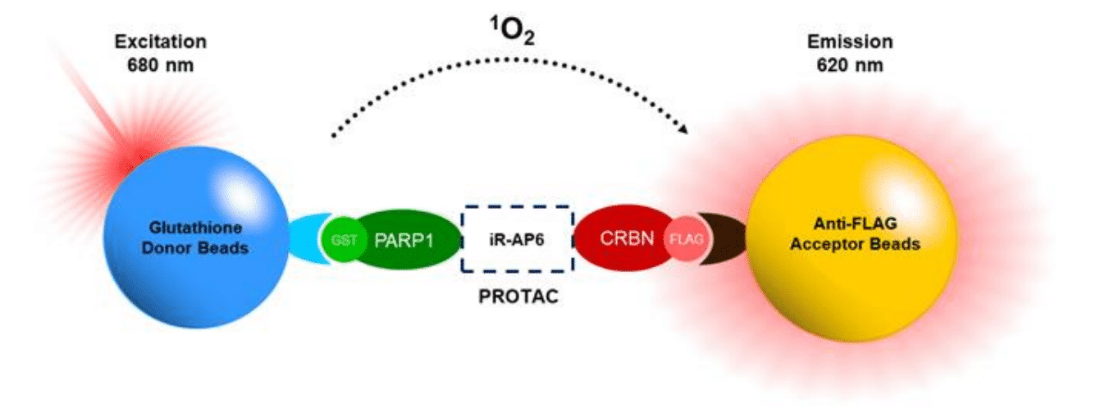Studying PARP family members is a high priority in cancer drug development
Are you keen to study PARP (Poly-ADP Ribose Polymerase) enzymatic activity, DNA trapping or PARP degradation? Then you’ve come to the right place. Take a look at this article that will provide you with the information you need to select the best PARP assay kit according to your requirements, to advance your cancer drug development research.
What key information to consider when choosing a PARP assay?
Measuring PARP activity in vitro involves a PARP substrate, NAD+, a DNA probe for DNA-dependent PARP 1-3, and purified PARP enzymes. All these components must be carefully optimized to ensure the sensitivity, robustness, and reproducibility of the assay:
- The protein must be enzymatically active and purified, without contaminants that would alter its activity. Constructing the recombinant protein with a tag facilitates affinity purification.
- Lot-to-lot testing: Protein enzymatic activity should be tested for each new lot of protein to ensure assay consistency over time.
- Titration of the protein in the assay development phase determines the optimal protein concentration to be used in the assay, for each PARP.
- Identifying the best DNA probe for PARP1, PARP2, and PARP3 increases assay specificity.
- In assays based on labeled NAD+, identifying the appropriate NAD+ mix is critical to the sensitivity of the assay. This must be determined for each enzyme to account for mono- or poly-ribosylation and enzyme kinetics.
Figure 1: PARP assay formats.
Throughput, number of steps, and low volumes are critical criteria of an assay designed to screen large compound libraries. Alternatively, overall assay cost or instrument availability may be the most important aspect of the assay for small research laboratories. What to consider when choosing an assay format:
- Instrument availability
- Ease of use
- Cost
- Sensitivity
- Throughput
- Time to completion
What are the solutions to your needs?
What are the solutions for studying PARP? Our partner BPS Bioscience has taken all these key parameters into account in order to develop the best PARP assay to meet all your needs. Let’s discover them:
ELISA-based enzymatic assays
Figure 2: PARP Assay – ELISA principle.
ELISA-based chemiluminescent and colorimetric assay kits are designed to measure PARP activity for drug profiling applications. Directly measures PARP enzymatic activity (PARylation OR MARylation) by measuring the incorporation of ADP ribose into a histone-based substrate. Inexpensive, stable signal with colorimetric assays, increased sensitivity with chemiluminescent assays.
Link for ELISA-based chemiluminescent here and for colorimetric assay kits here.
AlphaLISA® homogeneous assays
Figure 3: AlphaLISA™ principle.
AlphaLISA® is a technology developed by PerkinElmer that enables the directly measured of the enzymatic activity (PARylation or MARylation) by measuring the incorporation of ADP ribose into a histone-based substrate. This assay design is very advantageous for its short time to completion and is highly amenable to high-throughput applications such as drug library screening.
Link for AlphaLISA® homogeneous assays here.
PROTAC® optimization kit
Figure 4: PROTAC® optimization kit for PARP1 – Cereblon Binding principle.
PROTAC® Optimization Kit enables the measurement of complex formation between PARP and ligase. PROTAC (Proteolysis Targeting Chimera) causes protein degradation by targeted recruitment of ubiquitin E3 ligase. In theory, any protein of interest may be targeted. The PROTAC® Optimization Kit measures the formation of PARP1/Cereblon complex mediated by PROTAC of interest.
Applications: Compare the activity of different PROTACS & discover and optimize PROTACs targeting PARP1 and CRBN.
Link for PROTAC® optimization kit here.
PARPtrap™ assays
Figure 5: Principle of the PARPtrap™assay.
Most commercially available PARP activity assays quantify PARylation of target proteins, such as histones, and test only one PARP enzyme at a time. In contrast, the PARPtrap™ Combo Assay Kit for PARP1 and PARP2 compares a molecule’s ability to trap PARP1 versus PARP2 in the same assay. The capacity of a drug to trap PARP on the DNA is correlated with its cytotoxicity (clinical significance). This PARPtrap™ assay allows researchers to efficiently screen their libraries for the most specific and effective PARPis.
Link for PARPtrap™ assays here.
Conclusion
Sensitive, robust assays provide high-quality data within a short amount of time. Whether you are comparing a drug IC50 on all PARP family members or screening for PARP-trapping drugs, find the right assay kit at Tebubio.
Would you like technical information on these PARP assays?
Access to the webinar video
Acknowledgment
Special thanks to our partner BPS Bioscience, for their marketing content.








